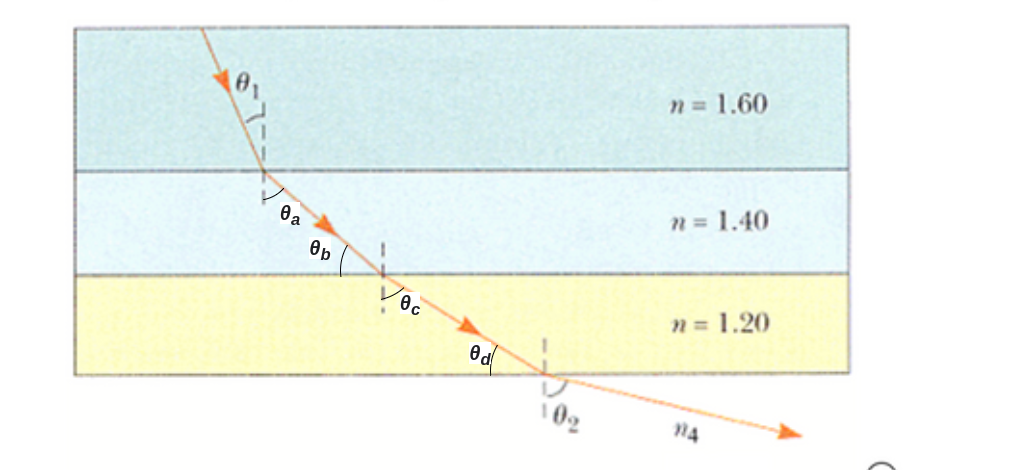The figure below shows the path of a light beam through several slabs with different indices of refraction. (n4 = 1.12) 0₂ n = 1.60 n=1.40 n = 1.20 (a) If 0₁ = 34.0°, what is the angle 82 of the emerging beam? (b) What must the incident angle, be to have total internal reflection at the surface between the medium with n = 1.20 and the medium with n4 = 1.12?
The figure below shows the path of a light beam through several slabs with different indices of refraction. (n4 = 1.12) 0₂ n = 1.60 n=1.40 n = 1.20 (a) If 0₁ = 34.0°, what is the angle 82 of the emerging beam? (b) What must the incident angle, be to have total internal reflection at the surface between the medium with n = 1.20 and the medium with n4 = 1.12?
College Physics
11th Edition
ISBN:9781305952300
Author:Raymond A. Serway, Chris Vuille
Publisher:Raymond A. Serway, Chris Vuille
Chapter1: Units, Trigonometry. And Vectors
Section: Chapter Questions
Problem 1CQ: Estimate the order of magnitude of the length, in meters, of each of the following; (a) a mouse, (b)...
Related questions
Question
100%

Transcribed Image Text:The image illustrates the path of a light beam passing through several slabs with different indices of refraction. The indices are labeled as follows:
- The first medium has an index of refraction \( n = 1.60 \).
- The second medium has an index of refraction \( n = 1.40 \).
- The third medium has an index of refraction \( n = 1.20 \).
- The final medium, where the beam is emerging, has an index of refraction \( n_4 = 1.12 \).
There are several arrows depicting the direction of the light beam as it refracts through each medium. The angles relevant to the light's path are denoted as \( \theta_1 \), the angle of incidence in the first medium, and \( \theta_2 \), the angle of the emerging beam in the last medium.
The questions posed are:
(a) If \( \theta_1 = 34.0^\circ \), what is the angle \( \theta_2 \) of the emerging beam? An input box is provided for the answer.
(b) What must the incident angle \( \theta_1 \) be to have total internal reflection at the surface between the medium with \( n = 1.20 \) and the medium with \( n_4 = 1.12 \)? An input box is provided for the answer.
Expert Solution
Step 1: Given Informations

In medium 1:
The angle of incidence on the bottom surface is .
refractive index is
In medium 2:
The angle of refraction at the top surface is .
refractive index is
The angle of incidence on the bottom surface is
Here, (alternate angles)
In medium 3:
The angle of refraction at the top surface is .
refractive index is
The angle of incidence on the bottom surface is .
Here, (alternate angles)
In medium 4:
The angle of refraction at the top surface is .
Refractive index is
Step by step
Solved in 3 steps with 24 images

Knowledge Booster
Learn more about
Need a deep-dive on the concept behind this application? Look no further. Learn more about this topic, physics and related others by exploring similar questions and additional content below.Recommended textbooks for you

College Physics
Physics
ISBN:
9781305952300
Author:
Raymond A. Serway, Chris Vuille
Publisher:
Cengage Learning

University Physics (14th Edition)
Physics
ISBN:
9780133969290
Author:
Hugh D. Young, Roger A. Freedman
Publisher:
PEARSON

Introduction To Quantum Mechanics
Physics
ISBN:
9781107189638
Author:
Griffiths, David J., Schroeter, Darrell F.
Publisher:
Cambridge University Press

College Physics
Physics
ISBN:
9781305952300
Author:
Raymond A. Serway, Chris Vuille
Publisher:
Cengage Learning

University Physics (14th Edition)
Physics
ISBN:
9780133969290
Author:
Hugh D. Young, Roger A. Freedman
Publisher:
PEARSON

Introduction To Quantum Mechanics
Physics
ISBN:
9781107189638
Author:
Griffiths, David J., Schroeter, Darrell F.
Publisher:
Cambridge University Press

Physics for Scientists and Engineers
Physics
ISBN:
9781337553278
Author:
Raymond A. Serway, John W. Jewett
Publisher:
Cengage Learning

Lecture- Tutorials for Introductory Astronomy
Physics
ISBN:
9780321820464
Author:
Edward E. Prather, Tim P. Slater, Jeff P. Adams, Gina Brissenden
Publisher:
Addison-Wesley

College Physics: A Strategic Approach (4th Editio…
Physics
ISBN:
9780134609034
Author:
Randall D. Knight (Professor Emeritus), Brian Jones, Stuart Field
Publisher:
PEARSON